“I do not want to glamourize war – I personally feel it’s always unnecessary….. but it’s fact, and the stories need to be told.” – Denny May
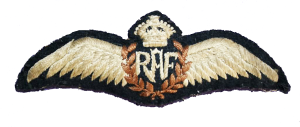 The toll in the Great War was devastating on all sides – the soldiers and airmen were doing their jobs – following orders – it was never fun and many of those who survived the war suffered badly in later years. My uncle (Jack Lickert) who was in the trenches suffered from the effect of gas & deafness from the guns, and pilots like Flight Commander Roy Brown suffered the effects of altitude sickness, and many others who all died much too young.
The toll in the Great War was devastating on all sides – the soldiers and airmen were doing their jobs – following orders – it was never fun and many of those who survived the war suffered badly in later years. My uncle (Jack Lickert) who was in the trenches suffered from the effect of gas & deafness from the guns, and pilots like Flight Commander Roy Brown suffered the effects of altitude sickness, and many others who all died much too young.
On the 9th of April, 1918 Lieutenant “Wop” May was transferred to #209 Squadron, Royal Air Force. (The R.A.F. came into being on April 1, 1918 – #209 Squadron was formerly 9th Naval Squadron of the Royal Naval Air Service).
Wop’s Flight Commander was a former school chum, from Victoria School in Edmonton – Roy Brown from Carleton Place, Ontario. Roy had the envious record during the time he was a Flight Commander that he never lost a pilot! Roy trained his pilots well – taught them further flying skills, took them over the lines for experience before allowing them into a combat situation. Wop’s log book for his early flights with the squadron reads….
9/4/18 Reported to 209th Squadron on April 9th flying Bentley Camels
11/4/18 Camel D3340 30 minutes Looking over ground and getting used to Machine
12/4/18 Camel D3340 90 minutes Balloon Patrol looking over the landmarks – visibility good
13/4/18 Camel D3340 45 minutes Line Patrol with G.C. – visibility poor
16/4/18 Camel D3340 30 minutes Target Practice
17/4/18 Camel D3340 60 minutes Target Practice
20/4/18 Camel D3326 60 minutes First time over the line. Flight got into scrap with triplane – archied (Enemy ground fire) slightly. Got in scrap with chap he crashed. I didn’t get a burst into them.
20/4/18 Camel D3326 105 minutes No EA seen on line Patrol – nothing seen
April 21, 1918 – was a day the world has never forgotten and a day where an event happened that will forever, it seems, asks the question “who shot the Red Baron”. The players were…
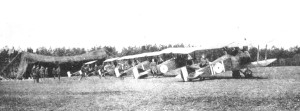
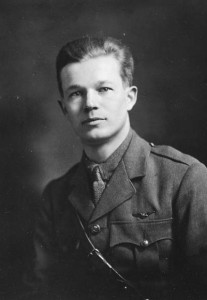
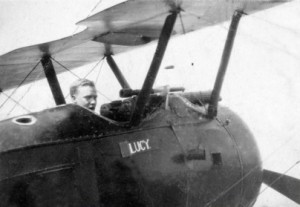
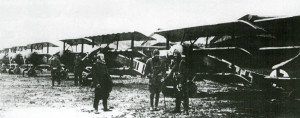
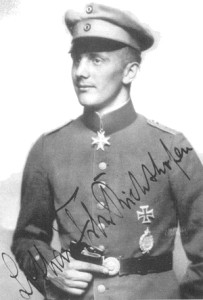
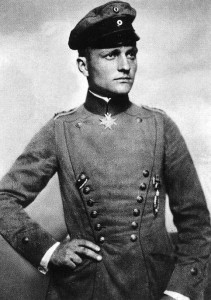
April 21, 1918 was a misty day and there was a 30 m/h east wind. At 10:00 AM 209 Squadron left the airfield at Bertangles and headed over the lines towards Cerisy. About the same time Jasta 11 left their airfield at Cappy and headed west. Both Wop May and Wolfram von Richthofen had been given similar instructions – “stay on top” “don’t get involved” “watch and learn”. They met well above the dogfight that was taking place below them – Wop saw the other plane and thinking it was an easy target attacked – and within moments found himself in the midst of a dogfight.
In Wop’s words at a speech given to the 12th Calgary Scout Troop on February 19, 1952 he said “There was a machine in sight so I was circling on top. A very pretty machine. The German machines were very decorative in those days. Just underneath me I noticed this machine, but again obeyed my instructions not to get into any trouble. This guy turned out to be the nephew of baron Richthofen. He had been given the same instructions as I had been given, that is how we both happened to be there. The second time he came up, I could not resist the temptation and took a crack at him, but I missed him, but he got underneath and in the circuit for protection. I woke up in the middle of the circuit, the machines were coming from all directions. They were firing at me, I was firing at them. Finally, I got so frustrated, so many of them coming at me, I had never seen any Germans before. Anyway, I went into a steep turn and then gave them hell and opened up my guns. That was where I made my mistake because my guns jammed, first one, then the other, and then I was caught and had to come out of it. In those days, we had to spin out of it into the sun for home – West – we were going East and needed to remember to turn and get going that way and go home. I did that and was patting myself on the back. At this time, there had not been a bullet put in my machine at all.”
The log book entry says:
21/4/18 Camel D3326 90 minutes Engaged 15 to 20 triplanes – claimed one. Blue one. Several on my tail, came out with red triplane on my tail which followed me down to the ground and over the line on my tail all the time got several bursts into me but didn’t hit me. When we got across the lines he was shot down by Capt. Brown. I saw him crash into side of hill. Came back with Capt. We afterward found out that the triplane (red) was the famous German airman Baron Richthofen. He was killed.
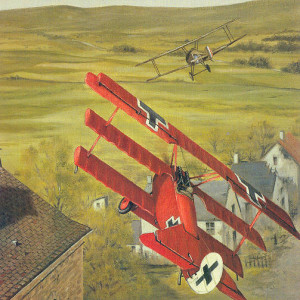
Briefly, the events that took place were:
- The wind had blown the “dogfight” west over Cerisy – Wop flew west down the Somme canal over the front line towards the town of Vaux-sur-Somme – Richthofen following all the way – shooting into his wings (seemingly trying to force the Camel down – he was a good enough shot that it would have been easy to shoot the pilot). Wop left the canal and flew into the village of Vaux-sur-Somme – an observer on a rooftop reported “two aircraft flying down the street below him” – at the end of the street was a Church.
- There is speculation that Richthofen had mistaken where he was – perhaps presuming the village was Sailly-le-Sec which was just over no-mans-land on the allied side of the lines. He broke off the chase and turned right – back into what he probably thought was safe territory.
- Roy Brown noticed the chase from above and dove his damaged aircraft down intercepting the action just west of the Church, and firing at the red Triplane.
- The Triplane turned right and over the most heavily defended part of the Somme – many people were shooting at him: Roy Brown, Australian Gunners, British Soldiers – one shot entered the aircraft from the right – the bullet hitting Richthofen in the rib cage and exiting through the upper left chest.
- Richthofen flew the plane to a field north of Vaux-sur-Somme and landed – the wheels broke off the aircraft which skidded to a stop in a cloud of dust. Gunner Ernest Twycross was the first soldier to reach the aircraft and heard Richthofen say “…… kaput” and then he died.
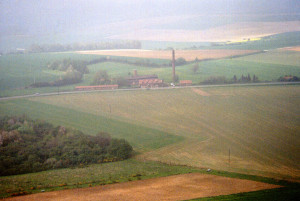
In May 2000 Denny & Margaret May along with son David & his wife Kimberly May traveled to France with Author Alan Bennett who co-wrote The Red Baron’s Last Flight – during the trip they had the opportunity to visit the Aerodromes of Bertangles & Cappy, fly down the Somme canal and take the same route the chase had taken 82 years previously and stand in the field where the Red Baron landed.
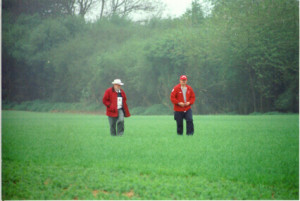
In this photo Denny & David May stand in the field where Richthofen landed. There have been many claims over the years by people claiming to have shot the Red Baron – but it seems very likely we’ll never know. I would suggest you investigate yourself – read the book “The Red Baron’s Last Flight” by Norman Franks & Alan Bennett. Check out the two volume set of books “Captain Roy Brown” by Alan Bennett.
Wop May continued to fly with 209 Squadron till the end of the war – he kept his log book until May 19, 1918 – the odds of living long as a pilot during World War I were not great and there did not seem to be much point keeping one’s log up to date. This excerpt from his log book on May 15, 1918 tells the story: “Escort and H.,O.P. (High Offensive Patrol) escorted D.H.4’s over. Met 2 Hun Scouts on a a French Spads tail. Chased them off Capt. Redgate got one. Went with D.H. 4’s when coming out about 12 Hun Scout Albatros were on D.H. 4’s tail. We chased them off and haggled with them. Captain Redgate and Brettorious and Wilson pushed off. Taylor and I stayed and scraped with them for about 15 minutes he got one and I got one. Both my guns jammed and I came home. Taylor joined the formation the ran into a bunch of triplanes. Wilson and Brettorious were shot down. One was thrown out of his seat and the other spun to the ground. Captain Redgate was wounded in the leg. Got home OK. 2 British fighter were also brought down. Taylor and I are all that’s left in A Flight.” Four Days later was the last entry in his log book.
During his service he was credited with shooting down 13 enemy aircraft (there were 4 others not credited – down out of control). He was wounded by shrapnel, spent time in the hospital with the flu and in September 1918 he was awarded the Distinguished Flying Cross (DFC) – the citation reading “This officer has carried out numerous offensive and low bombing patrols, proving himself on all occasions a bold and daring pilot……His keenness and disregard of personal danger is worthy of the highest praise“.
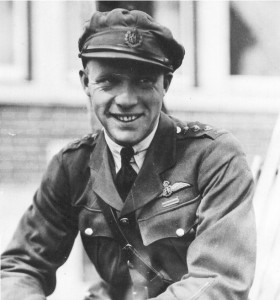
Captain W.R. May received a registered letter to his home in Edmonton mailed from the RAF Records office in Toronto, Ontario on December 3rd stating: “The Air Ministry advises by letter received at this Headquarters on December 1st, 1919, that you relinquished your commission in the Royal Air Force 8-5-19, your name appearing in the London Gazette dated 20-5-19.”